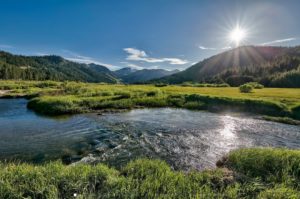Timberline Twister roller coaster tying Squaw Valley in knots
San Francisco Chronicle
A proposal to build a roller coaster-style ride on a hillside at Squaw Valley has inflamed tensions over the planned transformation of one of the world’s most picturesque ski resorts into a thrill-a-minute, year-round alpine wonderland.
The gravity car ride, dubbed the Timberline Twister, would race downhill through a forest overlooking a sprawling indoor water park, hotel and entertainment complex that was approved last year at the famed resort to the dismay of conservationists and many residents.
Critics have seized on the ride application, submitted Aug. 16 by KSL Capital Partners, as an example of what they call crass Las Vegas-style commercialism that threatens the laid-back ambiance of Tahoe.
“Does an amenity, or attraction, like this have a place in Tahoe? We would argue no,” said Tom Mooers, the executive director of Sierra Watch, a nonprofit environmental group that has been fighting development plans at Squaw for years. “KSL is hell-bent on securing development on a size, scale and scope that Tahoe has never seen.”
The coaster squabble comes as community leaders, environmentalists and businesses in the region struggle to plan for a future that may hold less winter snow due to climate change. Conservationists fear the region is on its way to becoming a year-round playground for the jet set, but many visitors and a good many bored locals don’t see a problem injecting more pizzazz into a 68-year-old ski resort.
“Our guests have told us loud and clear that they want more activity options when they come to visit,” said Andy Wirth, president and CEO of Squaw Valley and Alpine Meadows. “As part of a tourism-dependent economy, we are committed to remaining an attractive destination in a dynamic travel industry.”
Wirth described the ride as more of a bobsled on wheels than a roller coaster.
The single-person cars would be mounted on tracks on a 6-acre plot between the lower Far East and Red Dog chairlifts. A motorized cable would pull as many as 400 riders an hour 1,370 feet to the top of the hill, where they would be let loose. Hand brakes would allow some control of the cars, which would max out at 25 mph as they loop 3,380 feet down to the loading station.
The track would operate between 11 a.m. and 4 p.m., from Nov. 23 through April 27 as well as from June 15 through Sept. 7, according to the project proposal. Lights would be installed along the route, so the ride could run after dark or in foul weather.
Wirth said similar gravity rides have been built at 30 other resorts in the United States and Canada, including one at Heavenly Ski Resort on the south shore of Lake Tahoe. The Timberline Twister, he said, will help Squaw compete with the big resorts in Colorado, Utah and Wyoming.
“Unsurprisingly, Sierra Watch continues to try to mislead the community with the deliberate exaggerations and contrivances they’ve concocted,” Wirth said. “Their latest attempt to discredit the fact that our guests and customers at dozens of great resorts across the country — including Heavenly here in Tahoe — are seeking experiences like this as part of their vacation experience is just sad.”
Squaw Valley was expanded for the 1960 Winter Olympics and was, at the time, one of the great resort destinations in the country. But Wirth said the 6,000-acre ski area has deteriorated in important ways, and must keep up in the competition for tourism dollars.
The slope minders at Squaw are in a battle for supremacy with other resorts around the lake, including Heavenly, where millions of dollars have been spent on summer improvements. Developers are spending $250 million to turn Homewood Mountain Resort into a posh winter and summer mecca complete with a four-story hotel, two lodges, penthouse condos and a swimming pool.
Northstar California recently spent $30 million for a new high-speed quad chairlift and major upgrades to its ski village.
The gravity ride was first floated in 2012, when Squaw Valley and Alpine Meadows joined forces and began operating as Squaw Valley Ski Holdings. The company dropped the idea for a variety of reasons, including the drought, even as plans for an extensive expansion of the resort materialized.
Sierra Watch led the fight against the $1 billion plan to build 850 hotel, condominium and residential units, a shopping and entertainment complex and a year-round adventure camp in what is now the resort’s parking lot. The Village at Squaw Valley Specific Plan was approved by the Placer County Board of Supervisors in November 2016.
Wirth said the development will bring in $22 million in tax revenue, $20 million in transit initiatives and $150 million in new infrastructure, including road, utility and fire service improvements to the area. The project will also include the restoration of Squaw Creek, which was channelized before the Olympics, and Olympic Channel, which was diverted into a culvert pipe.
Besides destroying the outdoorsy, back-to-nature feel of mountain communities, Mooers claims the development will clog roads with traffic, spewing sediment into the Truckee River and harming Lake Tahoe’s clarity.
Sierra Watch sued in Placer County Superior Court, claiming the county and the developers violated the California Environmental Quality Act by not adequately assessing the project’s impact — particularly the 1,400 daily car trips that traffic engineers say the development will generate.
The group has also claimed county supervisors violated open-meeting laws when they approved the project, arguing, among other things, that a behind-closed-doors agreement by the developers to make payments to the Tahoe Regional Planning Agency to clean up Lake Tahoe was essentially a bribe.
Flush with victory, Squaw Valley this year revived the Twister. A long envisioned plan to build a gondola connecting Squaw Valley and Alpine Meadows was also dusted off. That project will go through a separate approval process.
Building the Timberline Twister would require removal of 59 of the 306 trees in the triangular-shaped forest where the tracks will be placed. Wirth said the new attraction is not expected to add traffic since most of the riders would already be at the resort.
What’s really at stake, detractors say, is the integrity of the mountain communities surrounding Lake Tahoe.
“I’m a dad and I understand how roller coasters make sense on some level, but does Tahoe really need another man-made attraction?” Mooers said. “Water slides, video arcades and roller coasters are fun, but the Tahoe experience should be about our lakes, rivers and trails.”
Peter Fimrite is a San Francisco Chronicle staff writer. Email: pfimrite@sfchronicle.com. Twitter: @pfimrite

